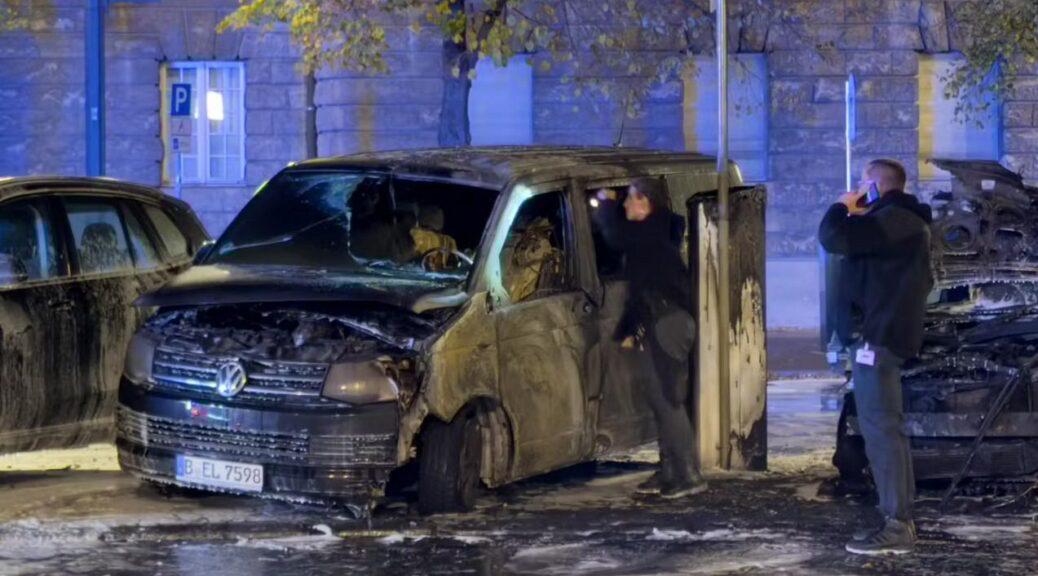
“And though some never returned,
they live on in every breath of freedom among us.
And though some fell in battle,
they stand by our side in every action.
And though some left us early,
they lead the way and pave our path.”
On the night of 24 October 2025, we set fire to an unmarked police car belonging to the Berlin police outside the Section 24 police station in Berlin. The unmarked police vehicles are parked on the central reservation on Kaiserdamm.
Sixteen people have already been shot dead by the police in Germany this year. And while family and friends are still trying to comprehend this brutal reality, the state and the press are blaming the dead. After Lorenz was executed in Oldenburg on the night of 20 April 2025 with shots to the back of the head, upper body, hip and thigh, lies about an alleged knife attack are being spread. Just as was done in the cases of Hussam Fadl, Lamin Touray, Mouhamed Lamine Dramé and countless others. If, thanks to public pressure, charges are brought, the uniformed perpetrators leave the courtroom with dismissals and acquittals.
Meanwhile, Black and migrant people continue to be subjected to racist police violence on a daily basis, enduring random checks, life-threatening pain holds and degrading abuse that all too often ends in death. This also affects homeless people, people with mental illnesses and LGBTIQ* individuals. Racist, criminal and deadly police practices are omnipresent. The unbroken belief in Germany in ‘the human behind the uniform’ seems to be a consensus in many minds, not despite but rather because of the Nazi past. This is evident in the established claim that right-wing police officers and soldiers are ‘isolated cases’, even though no one is able to count the multitude of right-wing extremist chat groups, networks supporting the NSU, and armed groups from “Nordkreuz” to ‘Nordbund’. And it is evident in the broad social acceptance of massive police violence, as long as it affects those who are marginalised as foreign, different or sick.
While relatives and anti-racist initiatives have to fight for every bit of visibility after police killings, the racist violence of the state has been openly and proudly displayed over the past two years when it comes to suppressing protests in solidarity with Palestine. The persecution of migrant organisations as part of German police practice is nothing new. In the decades-long criminalisation of Kurds and Turks under Section 129b, the German state exemplifies its pursuit of geopolitical interests. Good relations with Turkey are, among other things, an important basis for border deals and arms exports. As protests grew in response to the increasing killings in Palestine, German state policy coincided with a police apparatus that is historically rooted in the continuities of colonial exploitation and violence, Nazi history and militarism.
With political backing, the police stormed the demonstrations wherever and whenever they wanted, beating up people who chanted in Arabic, wore keffiyehs or demanded freedom for Palestine. The pattern has not changed much since the beginning of colonialism: people who are not recognisable to the police and the press as white and German are grouped together as a collective, assigned to a region and assigned stereotypical ‘cultural’ characteristics. In this way, a diverse movement of tens of thousands of people could be publicly placed under general suspicion of being a front organisation for Hamas, driven by anti-Semitism. The right to freedom of assembly currently no longer exists for the Palestine movement.
In Berlin’s schools, too, the state’s interpretative authority is to be enforced under the guise of alleged anti-Semitism prevention. Since 7 October, the Senate Administration has allowed schools to ban the wearing of Palestinian symbols. According to anti-discrimination agencies, this decree has led to massive intimidation of students.
But while every ‘From the river to the sea’ is reinterpreted as an anti-Semitic fantasy of extermination, actual attacks on Jews or synagogues are only of interest to politicians insofar as they can be used as ammunition to discredit the protests. The fact that thousands of the more than 6,700 cases brought by the Berlin public prosecutor’s office against the solidarity movement have been dismissed by the courts for lack of suspicion or relevance is unlikely to bother those responsible. The Berlin police have always preferred to punish protests themselves. Springer & Co take care of the rest with their ‘reporting’.
And before anyone gets the impression that this police state is sufficiently well established, let’s conclude with a look at Berlin’s new police law: ASOG. The black-red state government is creating a new police law that includes more video surveillance, state Trojans and, above all, a significant shift in the powers of intervention of the police. In Berlin, so-called ‘crime-prone locations (KbOs)’ were created years ago, such as Görlitzer Park, the U8 underground line and Rigaer Straße.
With the new ASOG, video surveillance is to be added to these locations, which will be evaluated using AI. This will also be possible for public events. Palantir’s ‘Gotham’ analysis software will make the masses of digital data usable for Berlin officials in the future. The Fraunhofer Institute’s ‘behavioural recognition AI’ is now to be used in Berlin, following its deployment in Hamburg and Mannheim. The plan is to train the AI with images from surveillance cameras in KbOs, recordings of endangered objects, and police footage from helicopters and drones. If the law is passed, the cops will be allowed to secretly install state Trojans in homes in future. This draft also deals with the cops wanting access to encrypted chat messages by allowing them to intercept these before messenger services encrypt them.
Fire and flames for the cops!
Freedom for Nanuk, Maja and all anti-fascists!
Freedom for the defendants in the Ampelokipi trial!
In memory of our comrade Kyriakos Xymitiris – ΓΙΑ ΠΑΝΤΑ ΕΝΑΣ ΑΠΟ ΕΜΑΣ
Unmarked police cars set on fire – Revolutionary hearts burn forever (Berlin,Germany)